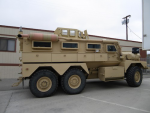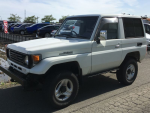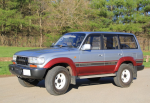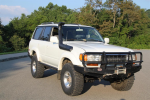So, you’ve got your bug out bag packed and ready to go, survival supplies laid in at your bug out location, and you keep your powder dry. Have you stopped to consider how you’re going to move people and gear around? Traveling on foot is slow (about two miles per hour for the average person) and your hauling capacity is limited to 50 or 60 pounds of gear, food, ammo, et cetera. More realistically, take a look at recreational backpackers; their goal is to carry no more than 30 pounds for movement of 10-15 miles per day. If you are bugging out with a family and children, the task becomes even more difficult, since they won’t be able to carry all of their own supplies. Let’s face it, you’re going to need a vehicle when the “S*%# Hits The Fan”. The question is, what type of vehicle is the best choice?
A quick Google search will produce some crazy suggestions. I have seen articles recommending a quarter million-dollar military MRAP (Mine Resistant Vehicle); a $60k highly modified, brand new Toyota Tundra pickup truck; a surplus military HMMWV; and a Mad Max creation of unknown origin. Sure, these make for cool Internet stories and great photos, but how realistic are they for the average person planning to survive a disaster? Let’s face it; they are poor choices for a number of reasons:
First, all of these vehicles create immense operational security (OPSEC) problems. If you’re driving around in a full tactical military rig, people are going to take notice. When the SHTF, they’ll know you have prepared and will come looking for supplies. It’s hard to keep a low profile when you look like the 3rd Marine Division rolling through town. In this, your pre-disaster OPSEC is completely blown, and now you’ve got to deal with dirt bags trying to rob you.
Second, these vehicles are incredibly expensive to buy and own. Long after you pony up the initial purchase price of $75k to $250+k, you’ll be paying outrageous annual personal property taxes and insurance. Most of these choices get terrible fuel economy (try 3mpg for an MRAP and 9mpg for a HMMWV), greatly increasing your pre-disaster operating costs as well as creating a bigger post-disaster fuel requirement.
Third, maintenance and repair parts are hideously expensive and hard to find. For example, I have a friend who maintains a corporate fleet of HMMWV’s, and he’s had to buy custom made replacement drive shafts ($2,000 each) and brake lines ($500 each) because the factory parts are no longer available. A post-disaster breakdown could render the vehicle useless and unrepairable.
Unless you have an unlimited budget, these outlandish vehicles are not an option, which brings us back to the central question, what is a good SHTF vehicle? Let’s consider the most important parameters in making this choice:
Fuel
Gasoline is readily available in normal circumstances but what about when the power is out and supplies are disrupted for weeks, months, or longer? Initially, fuel stations will have generators to run pumps and keep fuel flowing until their supplies run out. This could be several weeks in rural areas to as little as a few days in urban areas. Regardless of location, in the long term you will be limited to gasoline that you have stockpiled. Storing, transporting, and delivering gasoline is difficult and dangerous. It’s highly flammable and evaporates quickly. Modern gasoline (especially when blended with ethanol) is unstable and decays quickly. It can go bad in just a few months, unless treated with fuel stabilizer. Even in the best conditions, it won’t last much more than a year. If you must stockpile gasoline, buy the highest quality ethanol-free fuel that you can find, and use a first in-first out system of rotating stock.
There is no easily obtainable substitute for gasoline. An alcohol alternative could be distilled from crops, and this may be an option for people living near existing ethanol factories (generally in the Midwest), but most modern engines are only designed to run on a 10% ethanol/gasoline blend. If this is your plan, you’ll need an E85 rated vehicle (85% ethanol/gasoline blend). Otherwise, the vehicle will quickly suffer fuel system damage from the alcohol.
A much better choice is diesel fuel. It’s easier to store, safer to handle, and generally returns good fuel economy. Diesel fuel is stable and will last for years with minimal treatment. The primary concern in storing diesel is water contamination and algae growth, but if you start with clean, high quality fuel and add a biocide treatment, your fuel stores will last for many years, perhaps a decade. I have personally run diesel engines on untreated fuel that had been sitting in junkyard vehicle tanks for well over five years. Most importantly, in austere conditions, diesel vehicles can operate on a variety of substitutes, including cooking oil, waste oil, commercial or home-made bio-diesel, and even reclaimed motor oil. As a test, for the last four years I have been running a diesel Toyota on a mixture of diesel fuel and used motor oil in varying mix ratios. Other than additional exhaust smoke when the mix exceeded 50% motor oil, I observed no issues with performance or maintenance.
There might be an argument in favor of an electric vehicle. However, I suspect that expensive electric cars are going to be worthless once the grid goes down. Electric vehicles draw such significant power during recharge that many on-grid home electric systems are insufficient. One of the leading electric car manufacturers recommends a 50-amp, 240-volt service for recharging the vehicle at a rate of 30 miles of range per hour of charge. With current solar panel technology, this will require at least 800 square feet of solar panels. There would be no way to carry this with you, so the vehicle would be limited to round trips of roughly 200 miles and would be stranded in the event of a battery discharge away from home. This system would offer the benefit of powering your house when not charging the vehicle, but the installation cost may be shocking, so be sure to consult a solar specialist before going down this path.
Drivetrain
Anyone who has experienced a major snowstorm, power outage, or weather evacuation will tell you that when the grid goes down, traffic will be an immediate and ongoing nightmare. Without operational traffic signals, urban areas, cities, communities, and intersections will be gridlocked. Rural roads and open highways will eventually be littered with abandoned vehicles that have broken down or run out of fuel. Your concern will no longer be high-speed handling or ride quality. Conversely, in these conditions, a vehicle that can navigate rough terrain, cross medians, climb curbs, and handle urban sidewalks, forest trails, and fire roads will be imperative. The logical choice is a four-wheel drive pickup or SUV. These vehicles typically offer much higher ground clearance, heavy duty drivetrain and suspension, tougher tires, and generous load carrying capacity.
Modern or Vintage
Since the advent of electronic fuel injection, gasoline-powered vehicles have computer-controlled engines. They are very reliable under normal conditions but are quite complex to repair under austere conditions. In the event of an EMP (electromagnetic pulse), all of these vehicles will be rendered useless; there is no work-around for a failed computer. However, most diesel vehicles through the late 1990’s are powered with mechanically injected engines. They require no computer to operate, and many can actually continue to run without any electrical system, once started.
A Few Good Choices
Several vehicles that meet all of these criteria are 1990’s Toyota Diesel Land Cruiser and Toyota Diesel Hilux (4runner and Pickup). Toyota never sold these vehicles in the U.S. market; however, the rest of the world was lucky enough to have a ready supply. For almost half a century, these have been the preferred vehicle throughout Africa, the Middle East, and South America. Take a look at the worst environments in the world, from the heart of the Congo to the battlefields of Syria, and you will find the Land Cruiser and Hilux relied upon to get there and get back.
These vehicles share many basic components (brakes, wheels, tires, axles, et cetera) with their U.S. market counterparts. They are designed to operate for years in third world countries, so maintenance is straightforward. The suspension and frame are heavy duty and intended for rough terrain. Best of all, these vehicles don’t stand out as obviously different on U.S. roads. You can drive through town every day and the average person will barely take notice. Also, because they are 25 years old, they qualify as antiques, reducing tax and insurance costs.
Where to Buy
Finding a good, clean diesel-powered Toyota is not as simple as searching your local Craigslist. These trucks must be individually imported from overseas markets in full compliance with U.S. Customs, Department of Transportation, and EPA regulations. Although you can research the process and import a vehicle yourself, it is far safer to purchase one through a bonded importer who specializes in locating and importing low mileage examples directly from Japan. The importer will assure that your vehicle is legally imported and fully cleared through U.S. customs and a clean U.S. title. Another consideration is to select an importer with the knowledge and skills to recommend and install upgrades that you may desire, such as higher/heavier suspension, extended range fuel tanks, solar battery tenders, protective bumpers, winches, et cetera to suit your specific requirement.














